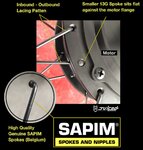We notice some users have some difficulty with the battery install and some intermittent power over bumps. We have had a little bit of time to understand the issue. Here is why there are some tight fitting battery packs.
Tora, have you checked New Atlas,( Gizmag), lately? There are some very interesting bits of new battery tech worth investigating.
The down tube of the frames are extruded like pasta then cut to the length required. The tubes are then CNC cut out. Basically its a precise drill that cuts out that battery cavity section.
The big packs (17.4 and 21.0 Ah) we make our selves and have more control.
The standard packs 8.8 Ah and 12.8 Ah packs we buy from Reention (
http://www.reention.com/product/2) the battery case, the upper and lower interface bits. The interface bits get screwed into upper and lower slots of the cavity that is cut out of the frame.
When you insert the battery, it should snap in and lock. Everything has to be millimeter precise or the pack will:
1. Rattle around and disconnect over bumps.
2. Be too tight and does not set all the way in and disconnect over bumps.
The tricky part from the manufacturing standpoint is that the parts are changing at different rates but they all have to come together with millimeter precision.
So the cavity of the downtube can be adjusted by adjusting the numbers in the CAD file which is used to CNC cut the tube, easy. The plastic parts are basically not changeable by us. they are injection moulded and sent to us, so we just buy it. Hard.
The thing is the company making the case and the battery parts sometimes make tiny changes to the design. We have to each adjust the CNC to the plastic parts. All this creates massive confusion, on a few of the Air bikes the section is a little too tight.
We have checked all the bikes as they come off the line and the battery can go in and lock solidly in place, yes but it is quite tight. Tight is better as the interface parts are plastic and can compress over time. There has been some reports from other assemblers of the pack being so loose they fall out. We have the opposite problem.
Most all of the packs that lost power is because the pack is not all the way seated and locked in place. One way to test this is to insert the battery, then try to pull the pack out without turning the key.
1. If the pack comes out without turning the key. It WILL disconnect over bumps.
2. If the pack stays locked in and can’t be pulled out, it is very unlikely the pack will disconnect over bumps.
The tricky thing on some of the bikes is the pack is so tight that tricks some users from thinking the pack is locked in when actually it is not. It is something like when you slightly close a car door. It seems closed, but its not really all the way closed. You have to use a bit of force to get it to shut completely. We found if you install and remove it a few times it gets much easier to do as the plastic beds in a little.
In the future productions we will have this issue solved, by firstly more carefully understanding the battery and interface bits more carefully before doing the CNC work.
So what if the battery still cannot sit in totally and lock in place even after pushing with more force? Contact our Tech support again and we have several ways to improve it and can get 100% of them to work normally.
